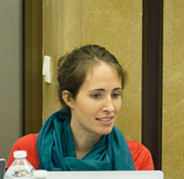Finance, Investment & Risk Management
Climate Change
Microfinance & Financial Inclusion
Insurance & Risk Management
Climate Adaptation & Resilience
Ph.D
United Kingdom
2012.08.31
Risk sharing mechanisms in rural India
Researcher Laura Munro conducted an experiment in rural Gujarat, India, to explore how selling to groups – versus individuals – affects the types of agricultural investments made by small-scale farmers once insured. She found that, in a context where investment decisions were public knowledge, selling insurance to groups caused people to take fewer risks in their agricultural activity. This can be a problem in certain contexts, because risk taking is sometimes necessary to achieve higher average productivity. The reasons Laura identified for this 8% reduction in risk taking, compared to an individual insurance context, involve group pressure. When distribution of the payout is at the group’s discretion, (previously) informal arrangements for sharing risk are formalised. The group can choose to give a larger portion of the benefit to members who have suffered greater losses. However, the fear that individuals taking bigger risks will then demand a bigger chunk of the payout creates pressure from the group to take less risk. If overall productivity suffers due to less risk-taking, this phenomenon could be happening at the cost of further development.
With climate change, the threat of severe weather is expected to grow and the need for such insurance is sure to increase. Laura Munro’s research shows that selection of the group covered, attention to the way investment information is exchanged, and regulation of payout distribution must all be considered in the design of these insurance products. Success in these areas could have a truly positive impact on development in some of today’s most vulnerable populations
Does Sharing Risk Mean Taking Less of It? Microinsurance and Group Pressure
In her own words...
My PhD research focuses on the implications of risk-sharing mechanisms and access to information for the welfare of smallholder farmers in Gujarat, India. The welfare of most low-income agrarian households in developing countries is severely constrained by risk. While informal insurance mechanisms to cope with such risks are prevalent, they are insufficient in the face of aggregate-level shocks such as drought and flood. Over the last decade, weather insurance has been promoted as a potential tool to help smallholder farmers cope with rainfall variation. To contribute to our understanding of the benefits and limitations of weather insurance for farmer welfare, I focus on two dimensions of this topic that may offer insights into how to improve the design and marketing of future weather insurance products.
First, I am interested the extent to which access to information may explain low take-up of weather insurance, a microinsurance product to insure the rural poor against drought and flood. Neoclassical economic theory predicts that risk-averse and utility-maximizing farmers will insure themselves against crop failure due to rainfall variation, but take-up of such weather insurance remains low. The first essay in my dissertation explores via a lab experiment with smallholder farmers in India to what extent differential access to information may account for this conundrum. Three channels through which access to information may influence decisions to purchase insurance are disentangled: (i) social learning; (ii) informal risk-sharing and (iii) free-riding.
Farmer welfare, however, is not only affected by how access to information affects take-up, but also by the subsequent effect of information on investment choices. In my second essay, I thus explore the varying implications of access to information in the context of group versus individual insurance structures for smallholder farmers’ ex-post investment decisions. This is based on the insight that - similar to joint liability micro credit with asymmetric information – group weather insurance could be subject to ex-ante moral hazard. A farmer may seek high-risk investments when able to hide these choices from the group and attribute any crop losses to rainfall deficiencies (in order to obtain a larger share of the group payout). Vice versa, under peer monitoring and approval, insured farmers may choose less risky investments and achieve lower average profits. My second experiment tests the effect of variations in insurance design and the level of monitoring on such ex-post investment decisions.
To add or modify information on this page, please contact us at the following address: community.research@axa.com

Laura
MUNRO
Institution
London School of Economics and Political Science
Country
United Kingdom
Nationality
British
Related articles
Finance, Investment & Risk Management
Societal Challenges
Microfinance & Financial Inclusion
Emerging Market
Inequality & Poverty
Joint Research Initiative
China
2021.04.19
Understanding the Financial Lives of Low Income Households in China
Leveraging financial diaries research methodology, this joint initiative aims to provide actionable insights about the financial lives of low-income households... Read more

Xiugen
MO

